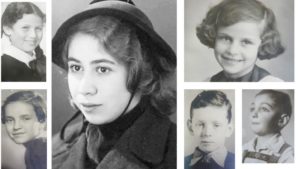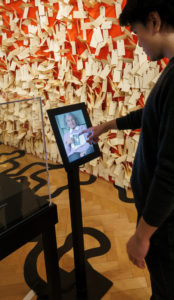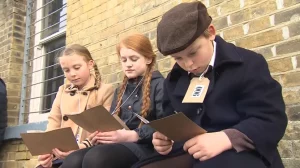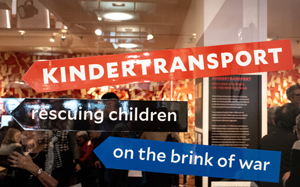On May 1st, the Ithaca community will get the chance to hear a firsthand account of one of the most tragic episodes in world history, the Holocaust, from a man who survived it. Gerd Korman’s family was separated during the war in various camps across Europe. They were finally reunited in the United States in 1946.
‘My Heart in a Suitcase’ will be performed at Thomas Edison and Roosevelt Intermediate Schools Tuesday. While every student in America learns about World War II, not many people remember the Kindertransport. Not many know that in 1938, as the Nazi rise to power began to spell a darker and darker fate for Jews, thousands of Jewish children from Germany, Poland, Czechoslovakia, and Austria left their homes on the Kindertransport and went to live in England in order to survive the war.

Children were admitted on the basis they were easy to ‘Anglicise’, researchers say. Children seeking sanctuary in Britain before the Holocaust were refused the lifeline of the Kindertransport if they were thought to have disabilities or looked too Jewish, say researchers.
Dutch filmmakers are appealing to British Jews to help them make a documentary about a social worker who became a Holocaust hero after helping 10,000 Jewish children reach safety via the Kindertransport. Resistance fighter Geertruida Wijsmuller-Meijer, whose nickname was ‘Truus,’ was honoured as Righteous Among the Nations by Yad Vashem, after her wartime efforts – including smuggling children out under her skirt – came to light.
Can a white person realistically make a film about racism that avoids this trap? Well, yes. It’s not just possible; it’s been done. The best example may be the 1964 film “Nothing But a Man.” Directed by Michael Roemer, a Berlin-born Jew who escaped Nazi Germany on a Kindertransport, and shot by Robert M. Young, also a white Jewish man, the film follows a black couple in Alabama.
The Kindertransport initiative was set up between 1938 and 1939 to rescue nearly 10,000 Jewish child refugees prior to the second world war. This resource explores The Guardian’s coverage of child refugees from Nazi occupied countries, along with a first hand account from Guardian journalist, Hella Pick.
n honor of International Holocaust Remembrance Day, 60 Minutes looks back at Bob Simon’s 2014 profile of Sir Nicholas Winton, who saved 669 children from the Nazis. An extraordinary story from the Second World War, a humanitarian story that didn’t come to light for decades. It concerns a young Londoner named Nicholas Winton who went to Prague, and ended up saving the lives of 669 children, mostly Jews, from almost certain death. His story begins in 1938, with Europe on the brink of war.
Before she became a world-renowned Sex Expert, Dr. Ruth Westheimer was 10-year-old Karola Ruth Siegel, one of thousands of Jewish children in Germany saying goodbye to their families for a life-saving journey. “If I had not been sent from Frankfurt. If I had not been on that train on January 5, 1939 from Frankfurt to Switzerland I would not be alive,” Westheimer said. Sadly, the rest of her family was murdered. An exhibit at the Center for Jewish History showcases the rescue effort.
An article in the London Financial Times written by the grandson in a family that took in two German Kinder. The Kinder are KTA members, and the families are still close.
He had quite a story. Bader was born in Vienna in 1924, and at 14 was sent to England (along with many others his age) to escape persecution. (His adoptive mother died in the Nazi camps, so this concern was extremely well-founded). In 1940 he was sent on to Canada, and he studied there at Queen’s – McGill’s quota for Jewish admissions kept him out of that university. He went on to Harvard for graduate work with Fieser, and afterwards found himself working in the chemical industry in Milwaukee.
Alfred Bader, a chemist, philanthropist and art collector who escaped the Holocaust in Europe and built a chemical company in Milwaukee, died Sunday. Bader was 94 and died peacefully, the family said. His wife, Isabel, was at his side.
After 80 years, survivors of the “Kindertransport” evacuation of Jewish children from Nazi Germany and elsewhere in Europe before World War II will receive compensation from the German government. The Conference on Jewish Material Claims Against Germany, also known as the Claims Conference, said the German government agreed to pay each person still alive a one-time compensation of 2,500 euros ($2,800).

Kindertransport: Rescuing Children on the Brink of War runs through May 24, 2019 at the Center for Jewish History in New York.
Multi-specialty design studio C&G Partners has created a highly emotional and thought-provoking exhibition commemorating the 80th anniversary of the start of Kindertransport, the humanitarian mission that sought to rescue 10,000 refugee children from Nazi-occupied Europe in the years leading up to the Holocaust. Kindertransport: Rescuing Children on the Brink of War runs through May 24, 2019 at the Center for Jewish History in New York.
Female volunteers such as Marie Schmolka played a decisive role in the collaborative project to rescue beleaguered Jewish children.

Children re-enact the Kindertransport journey 80 years on. Credit: ITV News Anglia
Schoolchildren across the region have been retracing the emotional journey of thousands of young refugees to mark the anniversary of the Kindertransport. Eighty years ago, the first Jewish children to flee the Nazis started arriving by ferry at Harwich in Essex. To mark the anniversary, students have re-enacted the journey at the stations of Harwich, Colchester, Ipswich and Manningtree.
Relics of this haunted but rarely examined chapter of the Holocaust are now on display in a small but stinging exhibit, “Kindertransport – Rescuing Children on the Brink of War,” a collaboration of the Yeshiva University Museum and the Leo Baeck Institute, that opened this week in Manhattan at the Leo Baeck Institute at the Center for Jewish History, through May 24, 2019.

Kindertransport – Rescuing Children on the Brink of War will be on view until May 24, 2019.
Nov. 26 several hundred people braved the rain to attend the opening reception of Kindertransport – Rescuing Children on the Brink of War. YU Museum, with the Leo Baeck Institute, has collected dozens of artifacts, ranging from teddy bears and letters to suitcases, games and a dress tailored for a young girl’s violin recital, with videos and audio to commemorate the rescue program undertaken only months after Kristallnacht in 1938 that brought 10,000 children to safety in the United Kingdom.
HIAS President and CEO Mark Hetfield addresses the Kindertransport Association at the Center for Jewish History in New York, December 2, 2018. Hetfield discussed the importance of remembering history and reminding the United States of its responsibility toward refugees. “We need your help in debunking this myth that nationalism is good and that a country should only look after its own…I need you to continue to speak out…we need you, we need your memory, we need your voice.”
This week is a particularly apt time to reflect on the legacy of US immigration policy in the 1930s. Eighty years ago this week, on December 2, 1938, the first group of Jewish refugee children arrived in Great Britain as part of a larger humanitarian effort to save Jewish children from the growing violence of the Nazi regime.
Clement Attlee, the Labour prime minister whose government founded the welfare state, looked after a child refugee who escaped from the Nazis in the months leading up to the second world war, it can be revealed. The then leader of the opposition sponsored a Jewish mother and her two children, giving them the confidence and authorisation to leave Germany in 1939 and move to the UK.